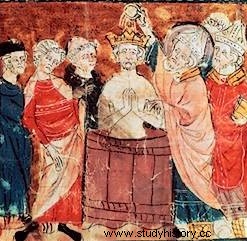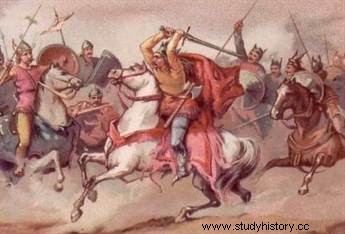 The Baptism of Clovis in Reims on December 25 498 (1 ), followed by 3,000 of his Frankish warriors, is a major event in early medieval history. With this conversion to Christianity, he secured not only the support of the Church, but also that of his Latin subjects - mostly Christians - and thus met the prerequisites for the rise of the kingdom of the Franks. This religious act also marks the beginning of the rebirth of Western Christian civilization , which nearly perished drowned with the Roman Empire under the blows of the invasions, and sealed a permanent alliance between the Roman Catholic Church and the Frankish and then French monarchy.
The Baptism of Clovis in Reims on December 25 498 (1 ), followed by 3,000 of his Frankish warriors, is a major event in early medieval history. With this conversion to Christianity, he secured not only the support of the Church, but also that of his Latin subjects - mostly Christians - and thus met the prerequisites for the rise of the kingdom of the Franks. This religious act also marks the beginning of the rebirth of Western Christian civilization , which nearly perished drowned with the Roman Empire under the blows of the invasions, and sealed a permanent alliance between the Roman Catholic Church and the Frankish and then French monarchy.
The Gallo-Roman world before the baptism of Clovis
When Clovis becomes the leader of the Salien Francs at the age of fifteen s in 481, he was only a wren (a "Rix") from a barbarian dynasty reigning over the region of Tournai, in Roman Gaul ravaged by more than a century of invasions. The golden age of prosperity version “pax romana” is only a distant memory, giving way to anarchy, famine and epidemics. Caulked in cities that are falling into ruins for lack of maintenance, the population has fled the countryside, demolishing monuments and temples to build enclosures. Trade becomes impossible, insecurity is permanent.
Facing chaos , the only institution that tries to maintain a semblance of civilization and organized social ties was, it must be said, the Catholic Church. Courageously, the bishops and the clergy faced the invaders, strong in the moral authority they had over a largely Christian Gallo-Roman population. Claiming Roman tradition and under the authority of the Pope, they keep the vestiges of ancient culture in their churches, determined to rebuild civilization. Fearing that the Western Church is also swept away by the chaos, it must find a political and military leader capable of restoring a semblance of order and unity.
This is where things get tricky. Whether the Visigoths settled in the southwest, the Burgundians in the southeast, or the Alamanni in the east, all the barbarian chiefs are Arians , a Christian heresy from the East which denies the divine character of Christ, preventing any rapprochement and even less an alliance with the Catholic clergy. Stuck to the northwest, there is indeed a remnant of a Gallo-Roman state, but its sovereign Syagrius is weak and its Romania a chimera with no future. There remains in the north an obscure leader of the Franks, Clovis , who practices a paganism without much conviction, which makes him more pleasant than the other barbarians in the eyes of the bishops.
The Franks in Gaul
The Franks , who came from Germany, gradually settled on the margins of the empire on the Rhine from the 3rd century. Federated by weakened Romans who entrusted them with the defense of the border, they could hardly oppose any resistance to the following invasions, including that of the Vandals in 407. They nevertheless gained a few stripes by participating in the resistance against the Huns, alongside the famous Roman general Aetius, and perhaps under the leadership of the mythical Mérovée . Slowly but surely, they are encrusting themselves in northern Gaul and Belgium, taking advantage of the slow agony of the Roman Empire.
 The Frankish Chief Childeric , father of Clovis, had quickly understood the importance of maintaining good relations with the Catholic Church and of being part of tradition, in order to consolidate his authority and his legitimacy over his Gallo-Roman subjects. He established diplomatic relations with Byzantium, the only true depository of the empire, and attracted the good graces of the Catholic clergy, drawing from its treasury to make donations to the churches, thus showing respect for the values and traditions that it represents.
The Frankish Chief Childeric , father of Clovis, had quickly understood the importance of maintaining good relations with the Catholic Church and of being part of tradition, in order to consolidate his authority and his legitimacy over his Gallo-Roman subjects. He established diplomatic relations with Byzantium, the only true depository of the empire, and attracted the good graces of the Catholic clergy, drawing from its treasury to make donations to the churches, thus showing respect for the values and traditions that it represents.
Over time, relations grew stronger and some clerics began to get used to the court of the Franks. So when his son Clovis succeeded him, did the Catholic Church already have influential contacts with the new leader of the Franks, including the Bishop of Reims Rémi . Despite his young age, Clovis already has a fine political sense and the pragmatism of his father, and is careful not to undo the links skilfully tied by Childéric. The church then saw an opportunity to make the young leader an ally of choice. Against all odds, the latter will prove to be tough to convince to embrace the Christian faith.
The alliance of the Church and the King of the Franks
As soon as Clovis came to power, Rémi sent him a letter in which he implicitly recognized his legitimacy and offered him the support of the Church if he pursued the policy of his father and deigns to listen to the advice that will be lavished on him by the ecclesiastics, even to take the step that his father was about to take before dying by converting. But it's still too early. The young leader is aware that he is surrounded by powerful barbarian leaders hostile to the Catholic Church and that his own people remain attached to pagan traditions , and does not intend to shake things up while his situation remains precarious.
Clovis prefers to reinforce the latter and settles for vague promises of conversion. He sets his sights on Romania, the Gallo-Roman kingdom of Syagrius. Cleverly, he was awarded by the Byzantine emperor the title of Patrice of the Romans to legitimize his invasion, and defeated the remnants of the Gallo-Roman aristocracy near Soissons. Always anxious to spare the Christian hierarchy, he had them return part of the looted loot, including the famous vase, but still refused to hear you talk about conversion.
The bishops did not despair and sent the fiery Frankish leader some signs of impatience, in particular by discreetly supporting the resistance of Lutèce , on which Clovis breaks his teeth. The defense of the city is encouraged by a famous Christian, Geneviève, the same one who, climbing the ramparts, would have promised the inhabitants that in the name of God Attila would not attack the city. But the message still did not get through to Clovis, who continued with some success the expansion of his domain, having his last Frankish rivals executed in the process.
 It was not until the year 491 and the death of Clovis's wife that an opportunity favorable to the Church finally presents itself. The Frankish leader was still young and in no mood to remain a widower forever. The bishops hastened to introduce him to Clotilde , a converted and convinced Burgundian princess. As she is beautiful and represents an advantageous alliance with a powerful neighbor, Clovis marries her in 492, granting to his wife Clotilde that the unborn children be baptized. The Church has in the bed of the Frankish leader an ally on the path to conversion to the Catholic religion.
It was not until the year 491 and the death of Clovis's wife that an opportunity favorable to the Church finally presents itself. The Frankish leader was still young and in no mood to remain a widower forever. The bishops hastened to introduce him to Clotilde , a converted and convinced Burgundian princess. As she is beautiful and represents an advantageous alliance with a powerful neighbor, Clovis marries her in 492, granting to his wife Clotilde that the unborn children be baptized. The Church has in the bed of the Frankish leader an ally on the path to conversion to the Catholic religion.
The baptism of Clovis in Reims
But the hope is short-lived, thwarted by the untimely death of the first son of Clotilde and Clovis. “If the child had been consecrated in the name of my gods, he would live again ”(2 ) roared the outspoken leader in his grief. Clotilde and Bishop Rémi did not despair of obtaining the conversion of the Frankish chief. It will be necessary to wait a few years and the Battle of Tolbiac in 496 so that the situation is finally unblocked. In great peril against the Alamans, Clovis no longer knows which pagan god to turn to to return the outcome of the fight.
Seeing his Gallo-Roman companions cross themselves and return to battle, he thinks of his wife's exhortations to embrace the Christian faith. Seized by doubt and despair, Clovis reaches out his hands to the sky and proclaims his helplessness "Jesus Christ, son of the God of Clotilde, if you allow me to triumph over my enemies, I will be baptized in your name. ”(2 ). Shortly after the king of the alamans is killed and victory changes sides. And the leader of the francs will not be able to escape this public promise for long. .
 Clotilde ends up convincing him definitively and Clovis announces the end of 498 (1 ) that he will be baptized on December 25 in Reims with 3,000 of his warriors. In addition to the choice of the date, on Christmas Day, we do not skimp on the occasion on the symbols, so important is the event. Remi Bishop of Reims assures the future convert of having received in a dream the glorious destiny that awaits Gaul and its sovereigns, defenders of the Christian faith, and the assurance of the protection of the Virgin Mary, making the future nation the daughter elder of the Church.
Clotilde ends up convincing him definitively and Clovis announces the end of 498 (1 ) that he will be baptized on December 25 in Reims with 3,000 of his warriors. In addition to the choice of the date, on Christmas Day, we do not skimp on the occasion on the symbols, so important is the event. Remi Bishop of Reims assures the future convert of having received in a dream the glorious destiny that awaits Gaul and its sovereigns, defenders of the Christian faith, and the assurance of the protection of the Virgin Mary, making the future nation the daughter elder of the Church.
The holy chrism, is deposited by a dove on the day of baptism in the hands of the bishop who anoints Clovis, giving the sacrament a sacred character. This rite will be reproduced for all the kings of France in the cathedral of Reims, the anointing of the oil contained in the Holy Ampulla entrusting them with divine legitimacy .
A slow evolution of Frankish mores
If Clovis's conversion seems sincere, he will have a hard time assimilating the teachings of the gospels. Listening to the account of the passion of Christ during his baptism, he exclaims, raising his fist in front of the dumbfounded prelates “If I had been there with my francs, I would have avenged Christ ! ”(2 ). Born and raised barbarian, he will keep barbaric customs and customs until the end. , using cunning and violence to extend and strengthen his power, getting rid of his adversaries and even his close relatives by murder.
Bad habits that will remain common among his Merovingian descendants s, much to the chagrin of the episcopate. It is moreover a strange cohabitation which will settle for three centuries between a Church henceforth protected and reinforced in its prerogatives, and a Frankish monarchy which, although consecrated, will persist in preserving its cruel barbaric mores and its "legislation of Germanic origin, the Salic law.
Never mind. Through his conversion, Clovis sealed a lasting alliance between the Catholic Church and the French monarchy in the making, saving by its victories Western Christianity from possible annihilation, inspiring by its example other royal conversions in Europe. It will nevertheless be necessary to wait for Charlemagne and his successors for this alliance to take on a real political and religious meaning.
(1) The exact year of Clovis's baptism is uncertain, varying between sources from 495 to 510.
(2) The words of Clovis quoted here and the related events were recounted well after his reign and should be taken with the usual reservations. As well as for the history of the Franks, essentially known by the later writings of Gregory of Tours, very influenced by Christian legends.
Bibliography
- The Baptism of Clovis:December 24, 505?, by Bruno Dumézil. NRF, 2019.
- Baptism of Clovis, Baptism of France:From State Religion to State Secularism, by Pierre Chaunu and Eric Mension-Rigau. Balland, 1996.
- From Joel Schmidt, The Baptism of France:Clovis, Clotilde, Geneviève. Threshold, 1998.
